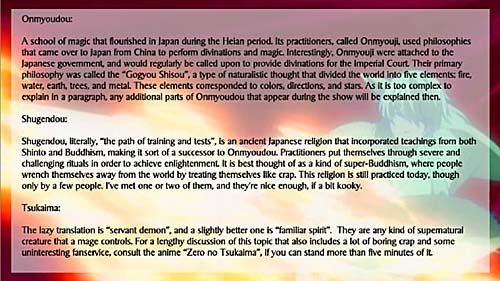Yes:
Category: Anime and Japan
Who is the unluckiest person in the galaxy?
Seina Yamada, of Tenchi Muyo GXP, or Ken the Brickmuppet? Consider this, this, this and this, and there’s plenty more in the archives.
*****
So there is a rumor that Bob Dylan might get the Nobel Prize for Literature. Well, okay. The Peace Prize is absolutely meaningless nowadays, so why not make the literary prize a joke as well? ((I am aware that some intelligent people think Dylan is a Great Artist, but in my arrogant opinion, he has but a modest talent for doggerel and none whatsoever for music.))
*****
High heels obviously make no sense for superheroines. ((Sailor Mars’ greatest superpower is the ability to sprint in stilettos.)) Neither does exposed cleavage.
*****
Advisory
Nightmares, mostly academic
From the aptly-named “Overthinking It,” an analysis of the political economy of My Little Pony: Friendship is Magic:
But the strong feminist themes of the series are built on a foundation of political contradictions. The most fantastic element of the show is not that ponies can talk or that dragons exist; it is the illusion that an egalitarian society can be maintained among groups with massive biologically inherent gaps in ability and economic utility. By even the most cursory of sociological and economic analyses, the society in MLP: FiM should be highly stratified along class and racial lines. And there are clear signs of that stratification, except they are obscured by a propagandistic focus on the power of “friendship”.
*****
“Unoriginal,” yes; “genius,” no:
… Goldsmith describes a course he teaches entitled “Uncreative Writing.” In this course, “students are penalized for showing any shred of originality and creativity,” and rewarded for “plagiarism, identity theft, repurposing papers, patchwriting, sampling, plundering, and stealing.” The course also involves such misadventures as modifying Wikipedia pages by inserting additional spaces between words and holding classes within the online game Second Life. The final exam consists of purchasing a paper from a paper mill and presenting it to the class as one’s own, on the basis of answering the question, “Is it possible to defend something you didn’t write?”
See also Professor Mondo’s note on Pierre Menard.
*****
I ain’t no damn academic and never will be, thank God.
“Gene, your writing style is very clear and concise. Very muscular. But it is not academic writing. It is popular writing. If you persist in writing clear prose, you will never get far in academic writing. Academic writing must be turgid and convoluted. You must force your reader to read your sentences four and five times before she can understand what you are trying to say. You must obscure the concepts that just anyone can understand. You must, as literally as possible, grab your reader by the throat and pull her face into the text, holding her captive until she can escape by understanding the essay in full after struggling and wrestling with your words.”
*****
Announcing the Société des Bozars:
We grant that television is a tragic addiction, and we yield to no one in our sympathy for its unfortunate victims. But why must the rest of us be prisoners of other people’s filthy habits?
Join the Société des Bozars today and raise your standard against aesthetic pollution. Make a pledge to patronize only establishments with no visible television sets.
One bonus of joining is that you need never set foot in an airport concourse or a McDonald’s again.
Winfield notes

When the international market for anime collapses, Japan can export fingerpickers. Akihiro Tanaka took second place in the International Fingerstyle Championship at the Walnut Valley Festival two years ago, first place last year, and was a featured performer this year. Meanwhile, Tomoake Kawabata placed second in this year’s contest Thursday.

In the pink
This has been a brutal year (-17°F in February, 110°+ repeatedly this summer) and it shows in gardens. Yews and arbor vitae are badly damaged if not dead, hostas are shriveled and sugar maples have few intact leaves left for their fall display. However, the naked ladies, a.k.a. Lycoris sqamigera, spent the worst of the heat undeground and look just dandy right now.
*****
I’m going to be away from the computer for a few days. While I’m gone, you can study the saxophone solo in “Tank!”
Odds and ends
Even disregarding the price, the sad fact is that the product delivered by the fansub groups via torrents is better than what we can buy. It’s more timely, and the quality is higher, and the resolution is better, and it’s more comprehensive.
I wish it weren’t so. I would rather buy than steal. But two years ago it reached the point where it didn’t feel like virtue to be honest. It felt like being a sucker.
Even as big as the anime market was in North America three years ago before everything fell apart, we were still being treated as second class citizens. Usually there was a delay of between 1 and 3 years before titles got released here, if they were. And what we got was 480p, which these days looks like a postage stamp to me. (Especially on my 1920*1080 computer display.)
Name that tune
Steven wonders if the background music in this scene from Dog Days is Mozart, perhaps from one of his opera overtures. I don’t recognize it, but my knowledge of Mozart and opera is not encyclopedic. Can you identify it?
One of the companies that worked on Dog Days is called “Studio Arkansas.” I wonder if they actually are from there.
Update: If the player above doesn’t work for you, try this.
The wrong place
Yu Muroga was a Japanese delivery man. He was doing his round when the earthquake occurred on March 11th 2011. Like most people in the area, he did not feel under the threat of the tsunami as he was driving far from the coast. That’s why he kept on driving and doing his job.
The HD video camera on his dashboard did not only film the tremors but also the moments after the earthquake when several drivers were trapped by the tsunami waters.
The video camera was recently found by the police next to the passenger’s body.
Click on the quote above to see the video.
(Via a comment at Eruptions.)
Before Cat Soup …
Testing …
If I have the feeds set up right, this post should appear at Anime Nano but not at Facebook. (Yeah, I am on Facebook, and no, I’m not very friendly. I’m there mainly to keep tabs on friends and family. If you want to know what’s on my mind, my weblog is the source to consult.)
Good news, bad news
The good news: There’s more Marie & Gali translated. Wasurenai is up to episode 27. That leaves 13 episodes to go of the first series, plus the 30 of Version 2.0.
Marika, a magenta-haired middle school student who favors EGL fashions and has no interest in science, finds herself marooned in Galihabara, an isolated town populated by famous scientists. They’re a little different there than they are in history books. Galileo is a buffoonish gonk, Newton is a snooty bishounen who only has eyes for his apple, Darwin is a robot, (John Ambrose) Fleming says “Yo!” a lot, etc. Fortunately for Marika, Madame Curie is relatively sane and provides her a place to stay.
Each of the five-minute episodes illustrates, sorta, a scientific principle. In the episode from which the screen captures above come, Archimedes, Hertz and Galileo compete in a fishing tournament. Through various ridiculous strategies, they catch enough fish and other aquatic creatures to capsize their boat, leaving them up lost at sea in a lifeboat with Marika. The episode ends with a brief lecture on bouyancy from Archimedes.
How much of the science kids watching the show will retain, I can’t say. It doesn’t really matter that much, though. Marie & Gali subordinates didacticism to broad, goofy humor, to its benefit.
The bad news: Captain Planet, the live-action movie. Please excuse me while I throw up.
“However, by that point …”
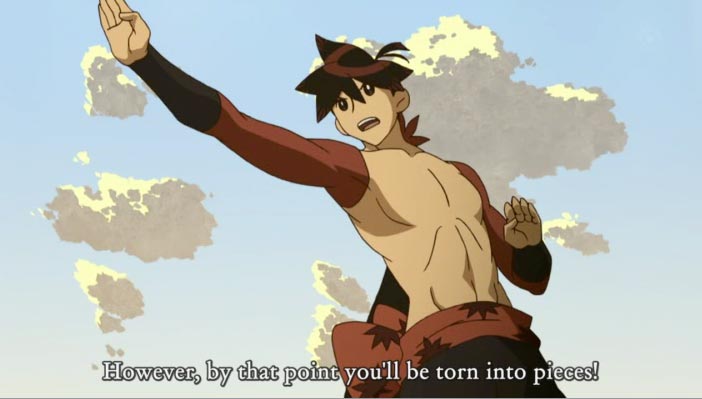
I lasted six minutes and fifty-five seconds the first time I watched Katanagatari. Earlier this month, when I had too many urgent tasks to accomplish and no desire to start any of them, I gave Katanagatari another chance. This time it held my attention, and I watched the rest of the series as quickly as I could download it. I can now state that 2010 has been a good year for anime, with three very different first-rate series (The Tatami Galaxy, Kuragehime and Katanagatari) and a first-rate movie (Summer Wars).
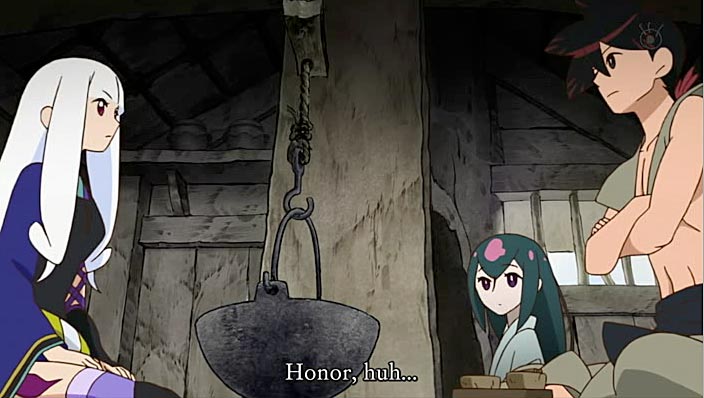
White-haired Togame, who proclaims herself “the army general director in support of critical tasks under direct control of Yanari Shogun of the Owari Shogunate,” searches for twelve “deviant” swords made by a legendary swordsmith. She drafts Shichika, the head and only living member of the school of Kyoutouryuu, the art of swordfighting without a sword, to assist her. Shichika has spent his entire life on an isolated island with only his father and sister for company; he’s nice enough, but naive, unsocialized and a bit strange. He’s one hell of a fighter, even though he wields no weapon. No ordinary swordsman can defeat him. However, none of his opponents are ordinary, and their swords are nearly magical. Some can scarcely be called “swords” at all.

Initially, Katanagatari seems formulaic: find the sword that gives the episode its name; learn the history of the sword’s owner; get the sword. Then comes episode four, in which we get to know Shichika’s frail and terrifying sister Nanami a little better. (Those poor, pathetic, murderous ninjas — they never had a chance.) And that’s as much of the story I’m going to tell you. I’m not going to even mention episode seven.
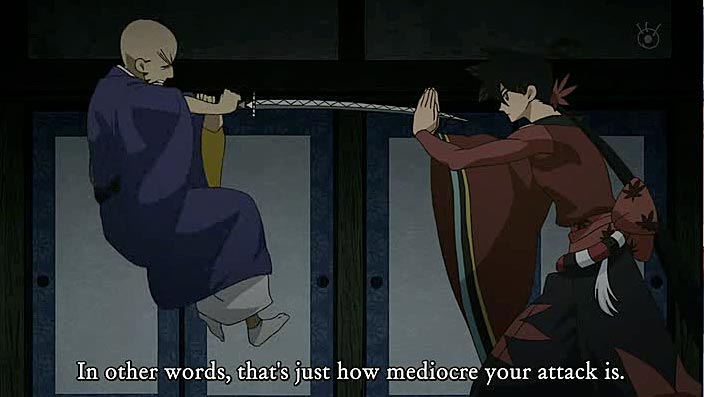
Although one would expect a lot of fighting in an anime concerned largely with swords, in fact most of each 50-minute episode is devoted to talk. The discussions between the guileless Shichika, the devious Togame and their varied opponents are ususally worth following, but if you’re mainly looking for action, you’ll be bored. When the characters do get around to actually fighting, though, the battles are spectacular. Because of the natures of the “deviant” blades and Shichika’s style, the fights often are more like magical battles than sword fights.
The character designs, apparently based on the illustrations from NisiOisin’s novels, take getting used to. Shichika’s and Nanami’s eyes are drawn without highlights, perhaps to emphasize their alienness. Nevertheless, their eyes are relatively normal compared to those of other characters. If the eyes are off-putting, though, the extravagant hair compensates. More eccentric than the eyes are the costumes worn by the dozen hapless ninja assassins. Most indicate an identification with a particular animal, and some are downright bizarre, e.g., those of the “Insect Squad.” While the character designs are simplified, the backgrounds are highly detailed. I was pleased to recognize Sakurajima in an episode set in Kyushu. ((Given how tectonically active Japan is, it’s surprising how rarely volcanic eruptions and earthquakes occur in anime.))
Katanagatari is sometimes comic, sometimes dramatic. Director Keitaro Motonaga usually handles the shifts in tone well, but he’s not the virtuoso that Akitaro Daichi is. The somber resolution of the story in the third episode is immediately followed by a jarring bit of slapstick, for instance.
The background music by Taku Iwasaki is mostly serviceable, but some pop/rap nonsense is quite annoying. Both openings are okay but not outstanding. Each episodes’s ending features a different song. The only one that isn’t immediately forgettable is that of the sixth episode, by Ali Project.
Katanagatari ends well with the spectacular twelfth episode. If you think there wasn’t enough fighting in the first eleven episodes, you’ll get your fill there. Despite the uncomplicated character designs, the series is probably too intense and thematically complex for children. It’s suitable for those high school age and older.

Post script: Memo to the otakusphere
Please don’t mention major plot twists at the beginnings of your blog posts, where those browsing at Anime Nano and Antenna will see them. Also, when you review a completed series, please consider that there might be someone who will read your article who hasn’t seen the show. At the very least, learn how to use spoiler tags. Too many bloggers announced the event at the end of the eleventh episode of Kanatagatari before I had a chance to see it, and I am not the least bit grateful.
Traveler from Tortalia
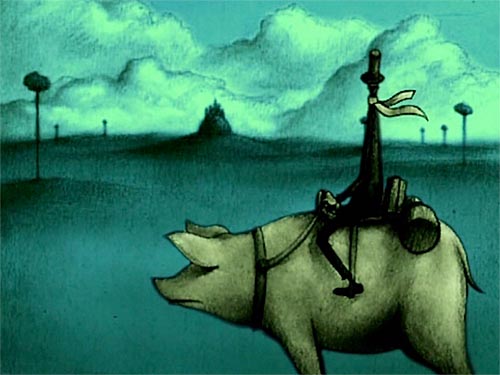
Some time back Wabi Sabi mentioned The Diary of Tortov Roddle. I recently came across a torrent. It’s an odd little series, consisting of nine short episodes. Seven concern Tortov Roddle, an etiolated traveler with a stovepipe hat exploring the northern plains. These are brief, surrealistic stores told without dialogue. In the first episode, for instance, Roddle sees a town on a hill and hopes to find an inn there. However, it turns out that the town is on the back of a gigantic frog, which leaves the hill for a lake populated by other frogs with towns on their backs. The penultimate episode, “Fantasy,” is a collection of brief vignettes too slight to summarize. The last is “The Apple Incident,” in which giant apples fall from the sky.
Rather than try to explicate the imagery, I’ll just post some screen captures below the fold.
Flouncy, frilly, ruffly, lacy
What does it mean to be a Lolita? According to Momoko Ryugasaki, it’s not just a matter of frilly clothes:
I have no strength, no stamina. I run really slow, and I can’t even swim. I’m hopeless at sports or anything physical. but I am quite happy with these failings of mine. After all, there’s nothing charming at all about a Lolita who can run a full marathon and clock a pretty good time doing it, is there? If a Lolita is assaulted by a hulking thug and uses judo to throw him over her shoulder, that’s just bad for her image. The weaker a girl is, the better. For a maiden, being frail and high-strung confers status. Once in a while at morning assembly there will be a girl who faints from anemia, and every time I see that I gnash my teeth with envy. Exasperating though it may be for those around her, a girl is decidedly cuter if she cannot do a single thing for herself — if she doesn’t even know how to tie her own shoelaces, I do not want to become the kind of woman who competently balances work and play, and is physically and emotionally robust, and is more suited to protecting than to being protected. I have no wish of becoming a woman of the world who has tasted both the sweet and the bitter things life has to offer. I don’t ever want to eat anything bitter — I plan on living my life by filling myself up with only the sweet. And if that gives me cavities, I’ll cry. If treatment is required, I’ll ask to go under general anesthesia because I hate pain. Call me a sissy and laugh if you will, but this is how a girl ought to be. She should just avert her eyes from the harsh realities and life and, without ever lifting a finger, dreamily devote herself to fantasies that will never come true. If she believes that one day those fantasies will miraculously come to pass, that’s all that matters.
Although Momoko, the narrator of Novala Takemoto‘s novel Kamikaze Girls, ((The Japanese title is Shimotsuma monogatari, or “Shimotsuma Story,” which is more accurate but less intriguing than the English-language one.)) calls herself a “Lolita,” there is no mention of Dolores Haze and Humbert Humbert in the book. Instead, the novel begins with a smart-alecky disquisisiton on the Rococo aesthetic — “… hey, round is cuter than square” — connecting it to punk and anarchism. Eventually Momoko gets around to talking about herself. She’s the high-school-age daughter of a Yakuza reject, whom she uncharitably but accurately calls “the Loser.” She lives out in the boonies near but not convenient to Tokyo, attempting to lead a Rococo life while surrounded by rice paddies in every direction. To raise money for more frills, she places an ad offering the counterfeit Versace clothing her father used to sell. Finally, on page fifty-two, Ichigo Shirayuri arrives on her elaborately tricked-out 50cc scooter to buy a jacket and begin the story:
The person had straight bleached-blonde hair down to her shoulders, wore blue eye shadow and bright red lipstick, and had on a navy-blue school uniform comprised of a short jacket and a very long skirt with a prodigious number of pleats, which dragged on the ground. On her feet were — well, it would sound good to call them “mules,” but actually they were cheap purple slip-on sandals of the type moms wear when going out to the neighborhood supermarket, and their sparkles glinted in the sun. Wow, a sukeban, and a super old-school one … Who knew bad girls wearing outfits like this still existed?
Although they represent mutually alien cultures, frilly-ass Momoko fascinates the hicktown Yanki. Ichigo frequently visits Momoko, and gradually a friendship develops, despite their having virtually nothing in common beyond outsider status. In the course of the novel Ichigo introduces Momoko to pachinko, the two search for a legendary embroiderer, Momoko gets more deeply involved with Lolita fashion, and Ichigo gets involved, too. The story culminates in a girls’ biker gang showdown, in which Momoko, to her credit, fails to live up to her ideal of the useless, helpless Lolita.
Takemoto didn’t worry much about plausibility when he wrote the novel. Although Momoko’s skill at embroidery is believable given her attitudes and history, what happens at her favorite clothing store is pure wish-fulfillment. What happens when she plays pachinko machines is plain fantasy. Ichigo’s unsuspected resource is just a little too convenient, if nicely ironic. And so on.
What salvages the book is Momoko’s voice. Sometimes playful, sometimes sarcastic, usually ironic and detached, the narration undercuts any latent sentimentalism. Momoko tries not to take anything seriously, and it’s not until the final pages that she lets her mask slip.
Kamikaze Girls was made into a movie, and apparently a pretty good one. I might track it down someday, though I expect that I’ll find it as disappointing as any other movie based on a book I like.
Lesser magics

At the center of Mokke is a pair of sisters. The older one, Shizuru, sees “things a normal human can’t see,” and the younger one, Mizuki, is susceptible to possession by those things. For reasons that will probably be explained later in the series, they left their parents to start a new life with their grandparents in rural Japan. Their grandfather is knowlegeable about those things that Shizuru sees, and he sternly lectures her on what she needs to do to protect Mizuki.
Mokke is a show of modest virtues. It’s a rather cheap-looking production, but there’s otherwise nothing really wrong with it, and I expect that it will be a tolerable kid’s show. The characters are non-neurotic and likeable and the premise has possibilities. Although it looks to be a series of horror stories, it’s not so intense as to give children nightmares (if the first episode is representative).
Shizuru and her impulsive little sister remind me of Yasako and Kyoko from Denno Coil, and the monster in the first episode initially resembles the “illegal” from the first episodes of DC. Shizuru’s ability to see the unseen also suggests parallels to Mushishi. And that is the problem with Mokke. Denno Coil and Mushishi are possibly the two best series since Haibane Renmei. Mokke isn’t bad, but it withers in comparison.
One point in Mokke’s favor: the artists actually know something about botany. The flowers in the picture of Mizuki above are clearly fireweed (Epilobium). During the episode, Mizuki searches for the “seven flowers of autumn,” and they’re recognizably drawn (though I’d quibble with one of the identifications).

I’ll give Rental Magica another chance before I abandon it. It’s about the dog-eat-dog (or monster-eat-monster) world of the rent-a-mage business. This is anime, so most of the mages are high school students. The first half of the first episode introduces a large cast of characters, none of them memorable. There’s a lot of action, but nothing really interesting happens.
In the second half, however, there is a story worth telling about a girl whose grandfather disappeared. If subsequent episodes concentrate on storytelling rather than action and seifuku, this could be a good show.
Shinsen Subs deserves special recognition for annotations beyond the call of duty, or tact.
This is a proper flying broom:
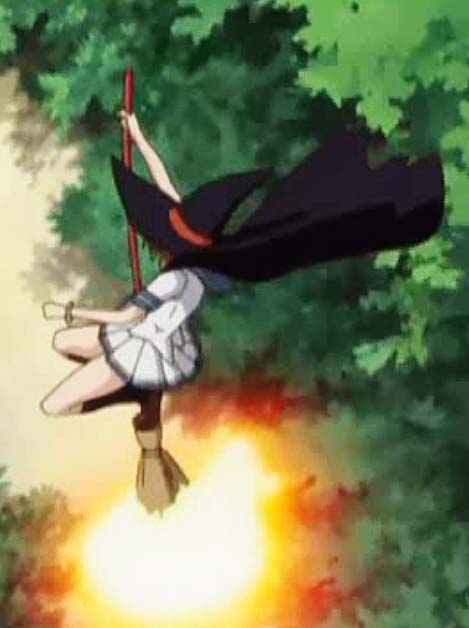
*****
Maybe Ghost Hound will be good. There’s also a show about kawaii bacteria. And that’s about all that looks intereresting this fall.
*****
My interest in watching any version of Gundam is precisely zero. Nevertheless, the most recent iteration provided the occasion for an interesting thread at Chizumatic.










